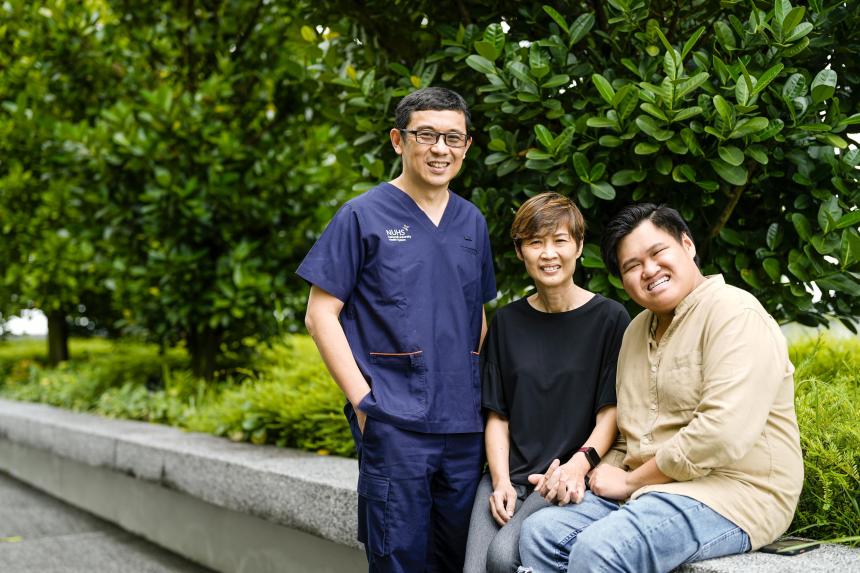SINGAPORE – A cell selection technique developed locally now gives blood cancer patients a faster and higher chance of finding a match for blood stem cell transplants, even from donors previously deemed not suitable.
The protocol also has a lower chance of transplant-related complications from, say, rejection of donor cells and infections.
The Haplo-2017 protocol, which was announced at a media briefing on Saturday at the National University Health System (NUHS), was developed by a team of haematologists from the National University Cancer Institute, Singapore (NCIS), together with clinicians from other local healthcare institutions.
More than 100 patients have been treated with the method since 2017, with the researchers working on further tweaks to get better outcomes.
Conventionally, blood stem cell transplantation requires a donor to have human leukocyte antigen (HLA) markers that fully match the patient’s, to lower the risk of transplant-related complications.
Generally, only three in 10 patients who need a transplant would be able to secure a full-matched donor within their family, from siblings or parents.
Each sibling will have a one in four chance of being a full match with the patient, while parents and children will always have only half their HLA markers matching.
Additionally, the chances of ethnic minorities finding a matched donor globally are lower, owing to their smaller population and the lack of minority participation in most donor registries.
The Haplo-2017 protocol makes haploidentical, or non-full-matched transplants a feasible treatment option for blood cancer patients who are not able to find stem cell donors with perfectly matched HLA markers.
Typically, in conventional blood stem cell transplants, all harvested stem cells from a donor are transplanted into a patient. But under this protocol, only non-harmful harvested stem cells are retained, while those that are known to cause rejections are removed.
Stem cells that can boost the patient’s immunity are also infused in the patient, thus lowering the risk of life-threatening infections.
Associate Professor Koh Liang Piu, senior consultant at the department of haematology oncology at NCIS and clinical director of the NCIS adult haematopoietic cell transplant programme, said that since the haploidentical blood stem cell transplant programme was introduced at NCIS in 2017, about 50 patients have been treated.
The outcomes have been comparable with those from full-matched donor blood stem cell transplants, added Prof Koh, who was instrumental in developing the Haplo-2017 protocol.
“There is now good data in Singapore to show that haploidentical blood stem cell transplant is a viable treatment option for blood cancers, such as leukaemia and lymphoma, and many other bone marrow disorders,” he said.
Blood stem cell transplantation is the only treatment that cures various types of blood cancers and bone marrow disorders, including leukaemia, myelodysplastic syndrome and lymphoma.
Blood cancers are also among the 10 most frequent cancers in men and women in Singapore, with NCIS seeing about 60 new cases of leukaemia and about 200 new cases of lymphoma every year.
More than 100 haploidentical blood stem cell transplants using the Haplo-2017 protocol have been performed here between 2017 and 2022. About 70 per cent of the patients had favourable outcomes, including no more signs of cancer and not experiencing transplant-related complications such as rejection.
Additionally, post-treatment, patients did not need to be on immunosuppressants that are known to cause side effects. Many patients also did not require readmissions to hospital due to transplant-related complications, said NUHS in a statement.
The protocol also allows blood stem cell transplants to take place sooner, compared with having to wait for a well-matched donor from a local or international registry.
For blood cancers such as acute leukaemia, time is of the essence, noted Prof Koh, who said haploidentical blood stem cell transplant can be an option if no perfectly HLA-matched donor is found in a timely manner. “Early treatment often gives rise to better outcomes, and any delay often results in disease progression and complications,” he added.
The overall incidence of rejection through graft-versus-host disease – or donor cells attacking the recipient – is also lower than other transplant methods.
“Most importantly, with the Haplo-2017 protocol, nearly all patients will be eligible for a haploidentical stem cell transplant as almost everyone has a potential half-matched donor in their family,” said Prof Koh.
Among the patients who have benefited from the new protocol is Madam Cynthia Tan, 59, who was diagnosed with high-risk acute myeloid leukaemia in October 2019 and went through three cycles of chemotherapy.
As her disease has a high risk of relapse without a stem cell transplant, she underwent a haploidentical stem cell transplant in March 2020 with her then 24-year-old son Keith Chan.
This was after an unsuccessful search for a full-matched donor among her immediate family members, as well as local and international donor registries.
Madam Tan continues to be in remission without having to rely on immunosuppressants and has also returned to her administrative job and hobbies such as running.
The NCIS team said it plans to further refine the Haplo-2017 protocol. This includes optimising the treatment regimen and stem cell dose to be infused, to lower the risk of rejection and disease recurrence. This, in turn, aims to achieve the best haploidentical stem cell transplant outcomes for patients.


